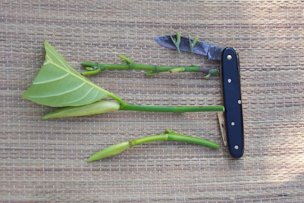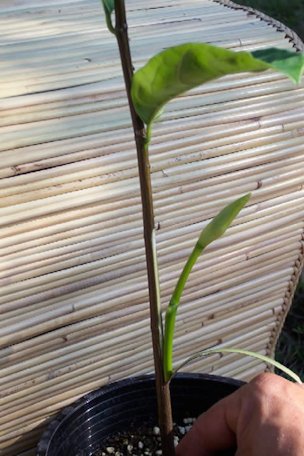Jackfruit Propagation By Seed From Species Profiles for Pacific Island Agroforestry 1 Jackfruit grown from seed usually produce acceptable fruit. The first generation of seedlings appears to retain about 90 percent of the characteristics of the parent. Seedlings tend to be more vigorous than their grafted counterparts. Seeds should be collected from trees that have regular, high yields and that also have good horticultural characters, such as insect, disease and nematode resistance, proper fruit size and excellent pulp quality. After opening the fruit with a large knife, seeds are separated from the fleshy sheaths that enclose the seeds. Each fruit contains 100–500 seeds; there is no correlation between fruit size and the number of seeds it contains. There are about 50–90 seeds/kg (23–41 seeds/lb). The thin, slimy coating around the seed (perianth lobe) should be removed and the seeds thoroughly rinsed in water to remove any remaining pulp juice or sugary residue. Only the largest seeds should be used, as these will give the earliest and highest germination and produce the strongest seedlings. Seeds may be air-dried in the shade for about an hour for ease of handling, but they should not be allowed to dry out, as this will kill them. Germination for seed sown within a few days of harvesting is usually high, around 90%. Seeds are recalcitrant, i.e., they do not retain viability when dried or stored for extended periods. They should be planted immediately for best germination and seedling vigor. Seeds can be stored moist in a plastic container in the refrigerator for up to a few weeks. Stored seeds germinate more slowly than fresh seeds. No seed pretreatment is required. However, soaking in water or a dilute gibberellic acid solution for 24 hours prior to sowing hastens germination and is recommended. Hot water treatment has been used successfully to stimulate germination. Germination begins in 1–3 weeks, or longer (up to 6 weeks) if seeds were stored more that a few days after collection. Daily watering is often necessary once seeds germinate. Jackfruit seedlings are very easy to grow. Seedlings develop very quickly, reaching 25 cm (10 in) in height within 3–4 months. Jackfruit Propagation by Grafting 2 By Richard J. Campbell, Ph.D and Noris Ledesma, Fairchild Tropical Botanic Garden Seeds are cross-pollinated and therefore not true-to-type, so grafting known varieties onto rootstocks is often done. Sown seedlings can be top-worked (grafted) with select varieties once they are established. 1 Grafting is the most reliable means of propagating a desired cultivar. Grafting joins together a piece of a mature, bearing tree (scion) with a separate seedling tree (rootstock) to form a permanent union. The scion forms the canopy of the tree and the rootstock the lower trunk and roots. Grafted trees will bear fruit in 2 to 3 years after planting and have a more spreading and open canopy than seedling trees. Jackfruit grafting is only now becoming a viable method of propagation. Today, grafted cultivars are common in India, Indonesia, Malaysia and Thailand and increasingly in South Florida. Rootstock: The proper rootstock provides a tree with a healthy root system and can influence growth and fruit traits such as tree vigor, size, and fruit quality. There has been little investigation into preferred rootstocks for jackfruit in the Western Hemisphere. Locally collected seed can be used, given that they form healthy and vigorous seedlings with a strong root system. Seedlings for rootstock should be grafted when less than one year old. They should be healthy and not rootbound, which will permanently weaken the jackfruit tree, resulting in poor growth and fruiting, and susceptibility to diseases. A rootstock can be grafted when the stem reaches the diameter of a pencil, or even smaller if budding techniques are used. When to graft. Grafting is most successful when daytime temperatures are 70 to 85F and nighttime temperatures are 55 to 65F, keeping in mind that the key to successful grafting of the jackfruit is the maintenance of vigorous growth. Veneer Graft. The modified veneer graft, with or without the retention of leaves is among the most successful techniques for grafting the jackfruit. This method requires active scions of 10 to 15 cm (4 to 6 in) with a swollen terminal bud. The last fully expanded leaf is retained. Long, shallow veneer cuts are made on both the rootstock and scion, exposing the cambium of both. The veneer cut stops short of the terminal bud of the scion. A short flap of bark is left at the base of the veneer cut on the rootstock to secure the scion during wrapping. The cut surfaces of both the scion and the rootstock are then joined and wrapped with plastic grafting tape or a rubber band, leaving the terminal bud uncovered. The grafted tree and container are covered with a clear plastic bag and placed in a bright, but shaded location and thoroughly watered. The terminal bud on the scion will unfold its leaf and continue to grow. Rootstock sprouts from below the graft should be removed. The bag can be removed after the scion begins to grow in 2 to 4 weeks. The height of the graft on the rootstock is not critical. The same method can be used with leaf removal on the scion, and these scions can be stored in a plastic bag at 12C (54F) for up to a week. Other successful techniques include chip budding, cleft and forkert grafts. The key to all of these methods is the vigor of the rootstock and scion, and the preparation of the budwood.  Fig. 1   Fig. 2  Grafting with a swollen terminal bud If possible grafted trees of known cultivars are preferred. Seedlings of 'NS-1' and 'Black Gold' jackfruit have been used as rootstock sources. For rootstocks, select vigorously growing seedlings that are healthy and eliminate stunted, yellow or chlorotic seedlings. Chip budding, side veneer grafting, cleft grafting, and approach grafting have been used, but mostly side veneer grafting. Select scions or budsticks from trees growing vigorously, preferably in the summer or fall. Cut bud sticks 4 to 6 inches (10-15 cm) long from shoot tips, remove all the leaves, and be sure that the terminal bud is swollen. Budwood may be prepared ahead of time by removing the tip and then collecting the scions when buds begin to swell, after a week or two. Bud or graft trees when the rootstocks are about pencil size in diameter. The tip of the terminal bud should be left uncovered when veneer grafting. Place grafted trees in a mist bed in partial shade or cover with a plastic bag and place in the shade. Jackfruit can also be propagated by air layers, but this method is not commonly used. 3 Jackfruit trees are greatly affected by root restriction (i.e., being pot bound) and develop a deeper and stronger root system if planted in large, deep, long (18-24 inches; 45-61 cm), plastic pots. When planted, pot-bound trees do not establish well and grow poorly. Large jackfruit trees (2-4 feet tall; 0.6-1.2 m) establish more quickly and grow better when planted out than do small trees. 3 Cuttings are not a common propagation method for jackfruit, nor have plants propagated in this manner been tested under field conditions. However, semi-hardwood cuttings with 3 leaves (leaves cut in half across the midrib) dipped in 5,000 to 10,000 ppm IBA (1H-indole-3-butanoic acid) and placed in an intermittent mist bed will root in about 60 to 70 days. 3 Back to Jackfruit Page | |
| Bibliography 1 Elevitch, Craig R., and Harley I. Manner. "Artocarpus heterophyllus (jackfruit)." Species Profiles for Pacific Island Agroforestry, Apr. 2006, www.agroforesty.org. Accessed 19 Dec. 2014. 2 Campbell, Richard J., and Noris Ledesma. "Jackfruit Propagation." Fairchild Tropical Botanic Garden, fairchildgarden.org. Accessed 19 Dec. 2014. 3 Crane, Jonathan H., et al. "Jackfruit Growing in the Florida Home Landscape." Horticultural Sciences Dept., UF/IFAS Extension, HS-882, Pub. date May 2002, Revised Oct. 2005 and Nov. 2016, Reviewed Dec. 2019, AskIFAS, edis.ifas.ufl.edu/mg170. Accessed 17 Jan. 2017, 6 July 2020. Photographs Fig. 1,2 "Jackfruit Propagation." Fairchild Tropical Botanic Garden, fairchildgarden.org. Accessed 19 Dec. 2014. Published 19 Dec. 2014 LR. Last update 31 Aug. 2020 LR | |